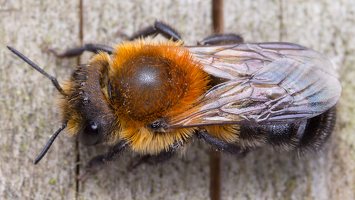 home / Insecta · vabzdžiai / Hymenoptera · plėviasparniai / Megachilidae · bitės lapkirpės / Osmia uncinata · osmija
home / Insecta · vabzdžiai / Hymenoptera · plėviasparniai / Megachilidae · bitės lapkirpės / Osmia uncinata · osmija

Osmia uncinata · osmija
- pinewood mason bee
- Rinden-Mauerbiene
- Suomuurarimehiläinen
- bosmetselbij
- hedmurarbi
In Europe its distribution covers northern Europe and the mountains of central Europe east into Asiatic Russia. Osmia uncinata is a wasp like mason bee with a yellow and black striped thorax which is quite variable in its colour and the degree of hairiness shown. They measure 7 - 15mm in length.
The flight period is from late April or May to early July. This species has a single-brood in any season. It chooses preexisting cavities: insect burrows in dead wood or bark, especially those of the longhorn beetle Rhagium inquisitor and has used drilled borings in wooden blocks; between the thick bark of pine trees. The cell partitions and nest plug are made of leaf mastic. The nesting sites require full exposure to the sun. The eggs are laid in these small cells, which the female then seals with a reserve of food. The larva develops to a pupa and an adult while sealed in the cocoon, where it overwinters. The adults emerge in the spring to mate and to set up their own nests.
Osmia uncinata is polylectic and has been recorded as utilising pollen sources from plants belonging to 10 different families. Meadows which border pine woods are possibly an important source of food by providing nectar to fuel the adults' flight and pollen to be provided for the larvae.


